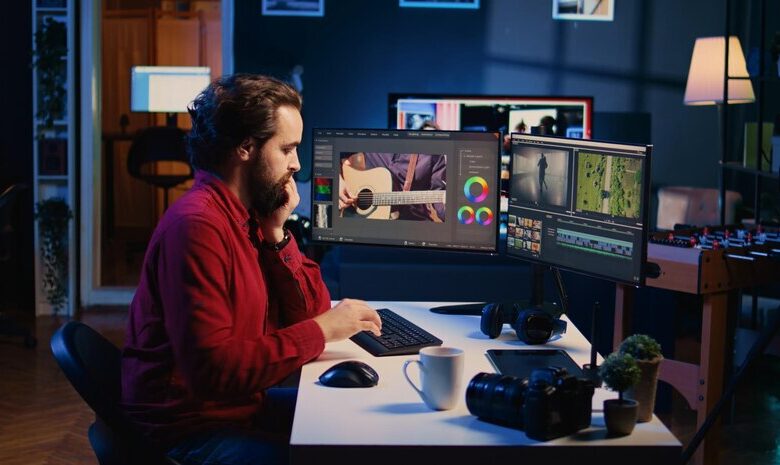The Evolution of Image Editing in Social Media: From Filters to Fine Art

In today’s digital age, the intersection of image editing and social media has transformed how individuals and businesses alike present themselves online. What began as simple filters and basic adjustments has evolved into a sophisticated landscape where creativity and technology converge seamlessly. From enhancing personal photos to crafting brand identities, the tools and techniques available for editing pictures have revolutionized the way we perceive and interact with visual content.
The Rise of Visual Storytelling
Social media platforms such as Instagram, Facebook, and TikTok have become virtual stages where millions showcase their lives, products, and services through carefully curated images. The demand for visually appealing content has never been higher, prompting users to seek out ways to enhance their photos beyond just basic cropping and filtering.
The Role of Image Editing Tools
Image editing tools have played a crucial role in this visual revolution. Applications like Adobe Photoshop and Lightroom have long been synonymous with professional-grade editing capabilities, allowing users to manipulate images with precision and creativity. These tools empower photographers, artists, and influencers to transform raw images into polished masterpieces that captivate audiences.
Accessibility and Convenience
While professional-grade software remains the gold standard for many, the accessibility and ease of use of mobile editing apps cannot be overstated. Apps like Adobe Express enable users to edit pictures with a few taps on their smartphones, offering a streamlined experience without compromising on quality. This democratization of editing tools has empowered a new generation of creators to express themselves visually, regardless of their technical expertise.
From Filters to Fine Art
Filters, once the hallmark of image editing on social media, have evolved into sophisticated presets that mimic the look and feel of professional photography. These presets, often available through both desktop and mobile applications, allow users to achieve specific aesthetic effects with minimal effort. Whether aiming for a vintage film look or a sleek modern style, these tools provide a shortcut to achieving a cohesive visual identity.
Beyond basic adjustments, advanced editing techniques such as layering, masking, and retouching have become accessible to amateurs and professionals alike. This evolution has blurred the line between amateur snapshots and professional photography, enabling anyone with a creative vision to produce stunning visuals.
The Impact on Social Media Dynamics
The proliferation of edited images on social media has had profound implications for how individuals and brands are perceived online. A carefully curated feed can attract followers, enhance engagement, and even drive sales. Brands, in particular, leverage image editing not only to showcase products but also to establish a consistent brand aesthetic that resonates with their target audience.
Influencers, whose livelihood often depends on their ability to create compelling visual narratives, rely heavily on image editing to maintain a polished online presence. The ability to edit pictures with Adobe Express or similar tools has become a cornerstone of their content creation process, allowing them to stand out in a crowded digital landscape.
Ethical Considerations
However, with great power comes responsibility. The prevalence of edited images has sparked conversations about authenticity and the potential for misleading representations. The practice of airbrushing or digitally altering appearances has raised concerns about unrealistic beauty standards and the impact on self-esteem, particularly among impressionable audiences.
Social media platforms have responded by implementing policies and tools aimed at promoting transparency and authenticity. Features such as Instagram’s “edited” label for altered photos and tools that promote body positivity are steps towards fostering a healthier online environment.
Looking Ahead
As technology continues to advance, the future of image editing in social media promises even more innovation. Artificial intelligence (AI) is poised to play a significant role, offering intelligent tools that automate complex editing tasks while preserving creative control. Machine learning algorithms can analyze user preferences and automatically suggest edits, further streamlining the editing process.
Moreover, the integration of augmented reality (AR) into social media platforms opens up new possibilities for interactive and immersive visual experiences. Users may soon be able to apply virtual enhancements to their surroundings in real time, blurring the lines between digital and physical realities.
Conclusion
In conclusion, the evolution of image editing in social media has transformed how we communicate, express creativity, and build online communities. From humble filters to AI-powered enhancements, the tools available to edit pictures with Adobe Express and other platforms have democratized creativity while challenging traditional notions of art and authenticity. As we look to the future, the continued innovation in image editing technology promises to redefine visual storytelling and shape the digital landscape for years to come.





